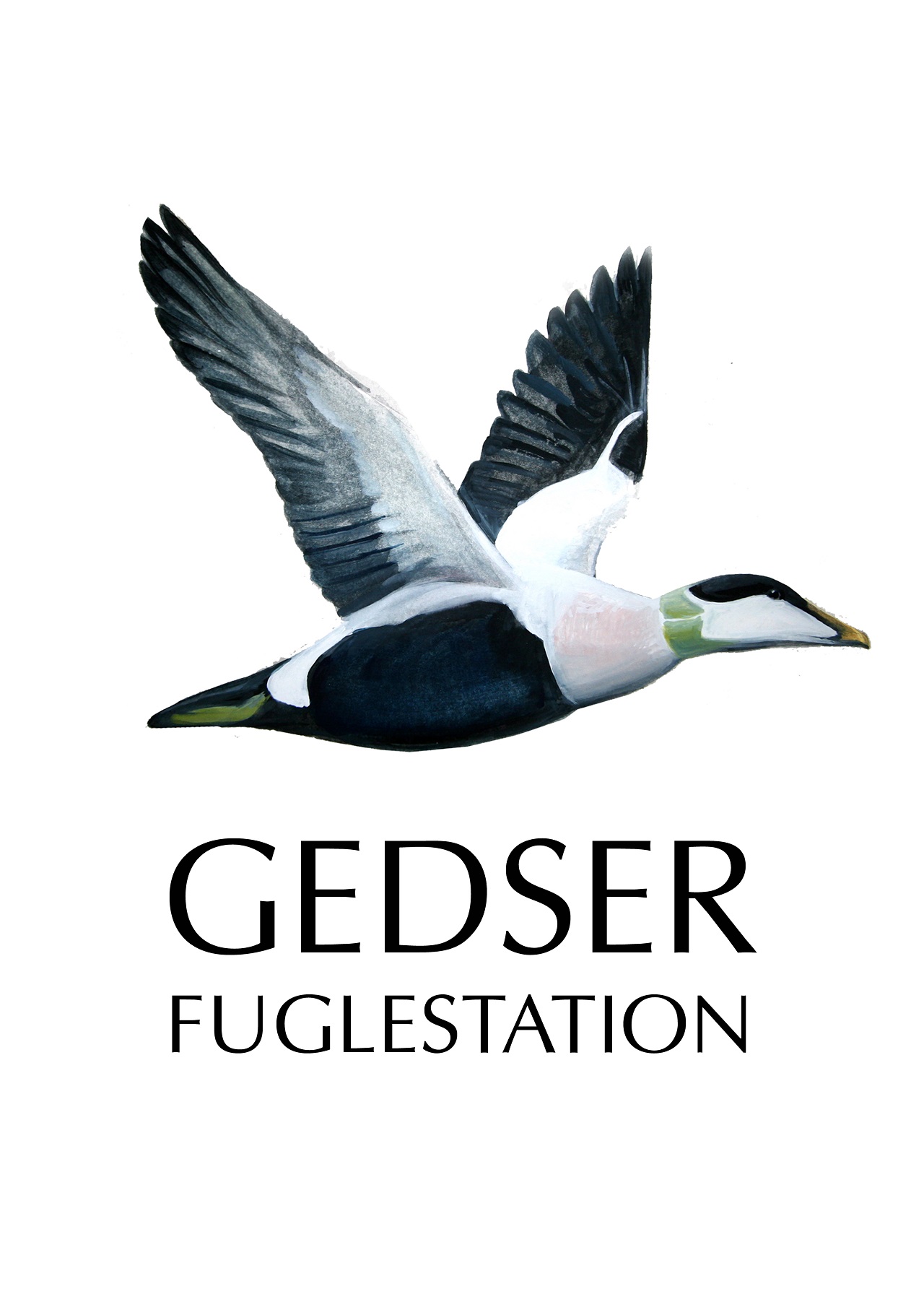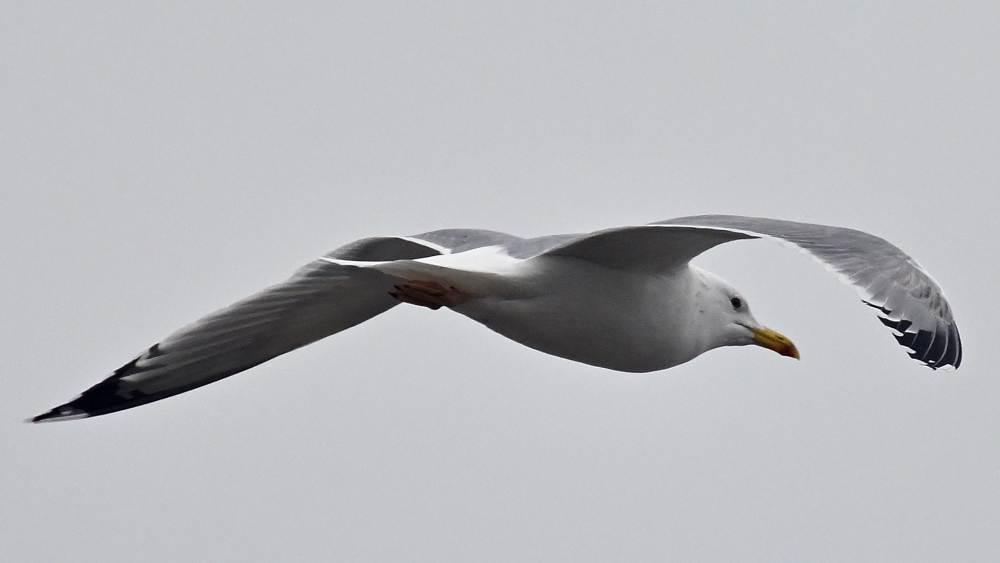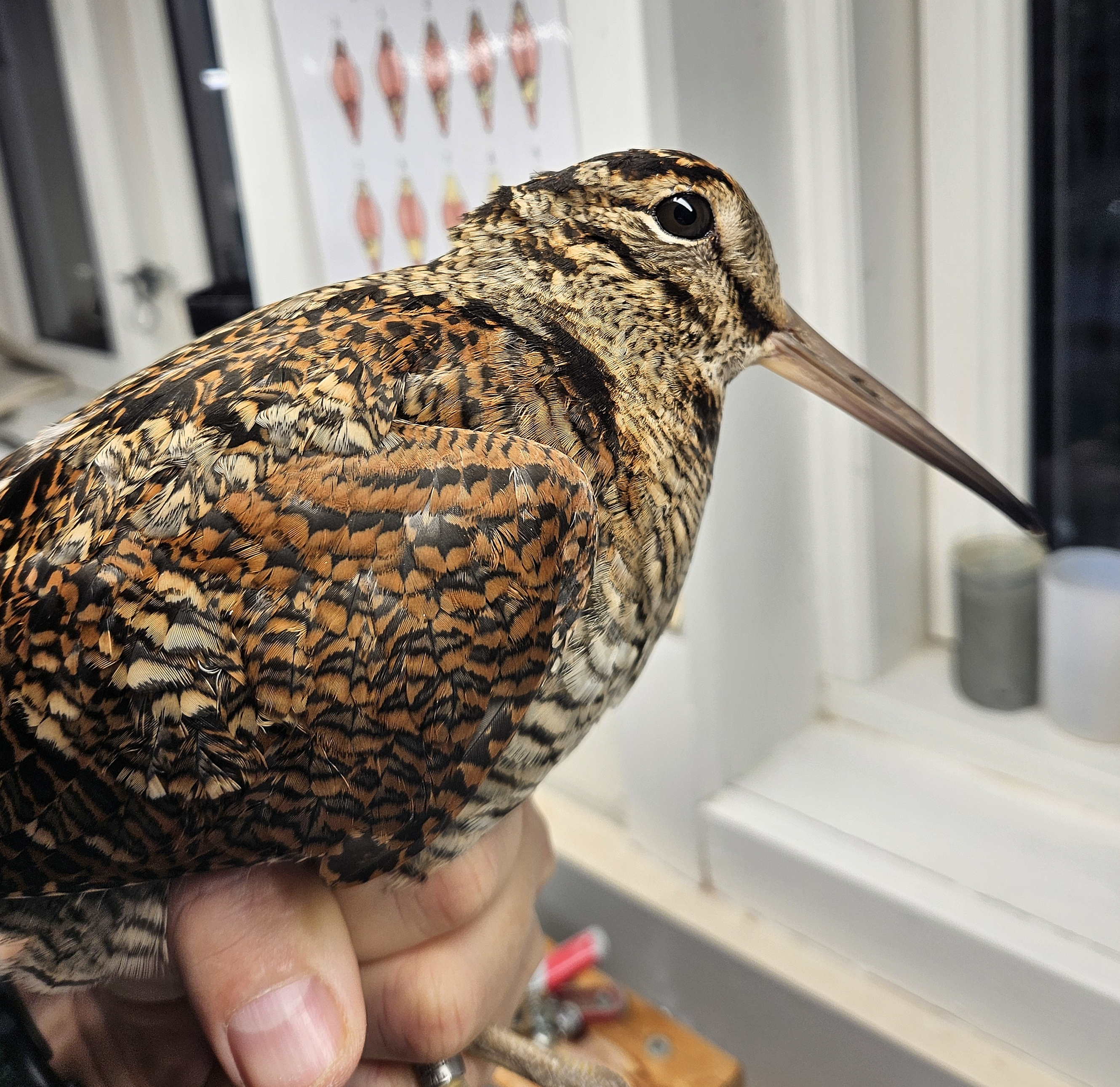Gedser Fuglestation Blog
Her på Gedser Fuglestations blog bringes korte nyheder i dagbogsformat om hændelser på fuglestationen.
Flot morgen med Suler og Kaspiske Måger
Ringmærkningen: Der var lidt mere vind i dag og da et par af nettene er slidte og grå kan de ses når vinden er på så desværre gik ingen drosler i nettene til morgen selv om der både var solosrte, vindrosler og sjaggere.
Heldigvis var der gevinst ad 2 omgange da 4 stillits røg i nettet.
Til aften gik jeg på aftensfangst da det var overskyet, så jeg skyndte mig at pakke ting til turen, men i al hast glemte jeg min astmaspray og det kom jeg til at mærke da jeg var kort fra Birkemosetrappen, så det tog lidt ekstra tid at gå hjem og næste gang husker jeg den. Der var ingen fugle på turen, kun en rotte som ledte efter mad i opskyllet. Rotter har jeg set flere gange på aftenfangst.
I morgen loves der kraftig vind så der kan ret sikkert ikke sættes net op.
Dagens ringmærkning/Todays ringing:
Stillits/Goldfinch 4
Trækket på Odden: Morgenen var rød, orange og lilla i mange skønne nuancere, og vi fik et glimt af solen; det er snart mange morgener siden, at det ikke bare har været gråt i gråt. Det var ren nydelse, så længe det varede, men efterhånden kom der et tæt skydække, og vinden drejede fra vest om i sydvest, så sydmuren på den gamle marinestation ikke længere gav fuldt læ. Heldigvis var der godt selskab; fra starten var vi tre fra fuglestationen, senere kom der en mere samt fire fra Næstved. Det er altid dejligt, når der kommer folk for at opleve trækket ved Gedser Odde.
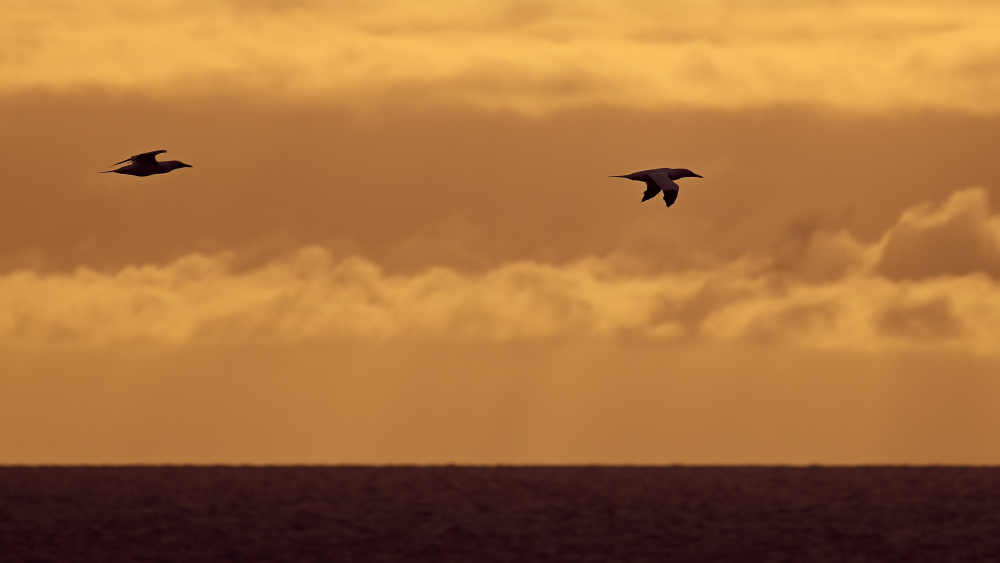
Trækket var beskedent, men det er ikke derfor, at denne dagbog slet ikke kommer til at handle om tal; det er, fordi vi tit taler om, at det er oplevelsen af fuglenes træk, der er hemmeligheden bag alle tallene, og som får os ud på Odden for at arbejde frivilligt for fuglestationen.
Det er mikset af mange arter og typer, farverne, når lyset er godt nok, at trækket starter med nogle arter, som efterhånden forsvinder ud af trafikken, mens andre dukker op. Hos nogle arter varer trækket så længe, at de også når at skifte dragter undervejs, så de sidste her i december ser helt anderledes ud end de første, der kom i august og september.
Hen over årene er der også arter, som forsvinder, og andre, der kommer til, fordi klimaet ændrer sig eller af andre årsager, som vi måske ikke helt kan forklare. I disse år kollapser bestande af Sølvmåger (Larus argentatus), efter at deres hovedkilder til mad – lossepladser, minkfarme og fiskeri er forsvundet. Samtidig bliver en anden type Sølvmåge stadig mere almindelig, nemlig Kaspisk Måge (Larus cachinnans), som breder sig så hurtigt fra Centralasien mod nordvest, at selv kortet i DOF/BirdLige Danmarks flotte digitale værk om fugle, Danmarks Fugle, ikke længere er korrekt. De nærmeste ynglekolonier er så tæt på som Belarus, Polen og Berlin i Tyskland, og det giver flere Kaspiske Måger i Danmark.
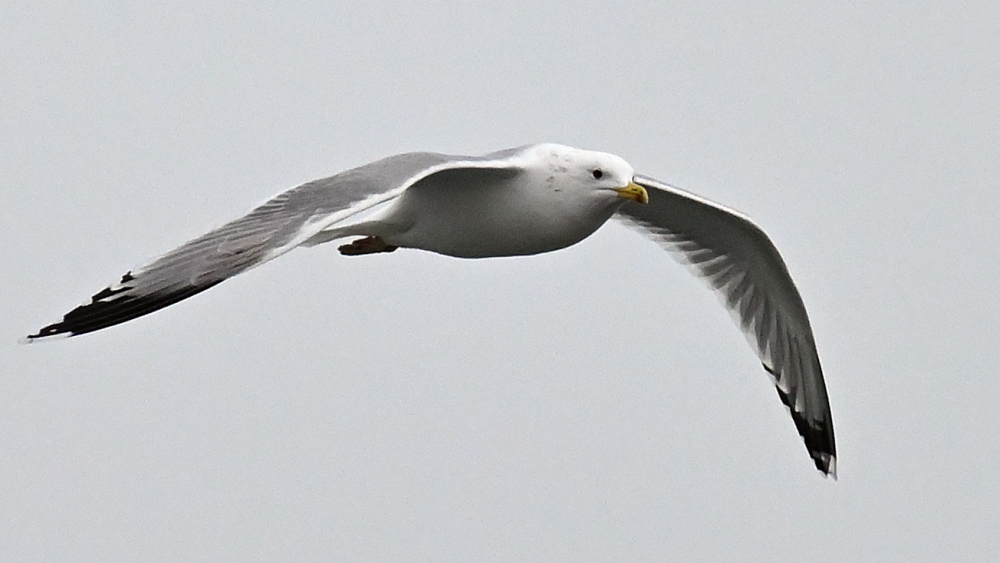
Blandt de Sølvmåger, der ledte efter mad i tangopskyl tæt på stranden ved Odden søndag formiddag, fandt vi flere Kaspiske Måger. Lige nu springer de voksne/adulte fugle i øjnene på lang afstand ved at have (næsten) rent hvide hoveder i vinterdragten til forskel af de mere hjemlige Sølvmåger, som har mange grå striber på hovedet.
Tak til Anne Marie Reith, Louis A. Hansen, Gert Juul Jeppesen plus de fire fra Næstved for at gøre en kold arbejdsdag lunere.
Se alle dagens observationer fra Gedser Odde i DOFbasen.
Folk på stationen: Henrik Jørgensen, Ole Friis Larsen.
Moderat træk i vinterens første snevejr
Ringmærkningen: Nettene blev sat op, men hurtigt lukket ned igen, da det begyndte at sne. Det blev derfor kun til en enkelt fangst af en Solsort (Turdus merula). En plan om at gå på nattefangst blev droppet, da lyset fra Månen var for kraftigt og gjorde det umuligt at komme tæt på fugle på stranden og marker uden at blive set.
Trækket på Odden: Vi var tre observatører i snevejr, og selv om vinden var isnende kold fra sydvest, fejlede humøret ikke noget denne lørdag morgen og formiddag på hele Nordens sydligste punkt. Senere kom ringmærkeren og en anden frivillig til, så vi var helt op til fem i ly og læ på den gamle marinestation. De barske forhold gav dog lave tal for dagens træk.
Selv om 687 fugle fordelt på 25 arter ikke er stort, var der nogle fine oplevelser. Dagens to Suler (Morus bassanus) var nok til at sætte en ny rekord for de seneste år, idet antallet af Suler ved Gedser Odde i år dermed foreløbig er på 119 og dermed over antallet på 118 for hele 2022. Tusindvis af Suler døde af fugleinfluenza i verdens største ynglekoloni, Bass Rock i Skotland, da epidemien rasede i 2021 og 2022. Det samme skete i Tysklands eneste ynglekoloni af Suler på Helgoland, og det var sikkert det, vi også kunne aflæse, da vi sidste år kun registrerede 65 Suler flyve forbi Gedser Odde. Derfor var det smukt denne lørdag at opleve, at Sulerne er ved at være tilbage på niveauet fra før den dræbende influenzaepidemi.
Fire Mørkbugede Knortegæs (Branta bernicla bernicla) vakte også opsigt. Det er højarktiske gæs, som kommer til Danmark helt fra nordkysten af det østlige Sibirien for at overvintre i blandt andet danske fjorde og andre lavvandede områder, men det er flere uger siden, vi har haft deres hovedtræk ved Gedser Odde.
Fra land vakte først en og lidt senere yderligere fire Snespurve (Plectrophenax nivalis). Hvilke andre småfugle ville være mere passende at se på udtræk i vinterens første snebyge
Se alle dagens observationer fra Gedser Odde i DOFbasen.
Folk på stationen: Klaus Dichmann, Henrik Jørgensen, Ole Friis Larsen.
Igen flot antal ringmærket
Ringmærkningen: Der var en lille smule mere vind til morgen, men stadig rigtigt fint til fangst.
Det blev også en rigtig god morgen med 22 ringmærket, og de 15 af dem blev fanget i et net på en af runderne. Omkring 11 tog vinden lidt mere til og det gjorde også at småfuglene forsvandt, så 12.15 lukkede jeg.
Under ringmærkningen fløj der et par misteldrosler over, og også ldt blandede småflokke med bog-og kvækerfinker. En del solsorte raster i haven, men de undgår nettene så tænker at det er fugle som allerede er fanget og ringmærket.
I morgen loves lidt mere vind, men slet ikke så meget at der ikke kan ringmærkes.
Dagens ringmærkning/Todays ringing:
Gærdesmutte/Wren 2
Vindrossel/Redwing 1
Stillits/goldfinch 2
Grønsisken/Siskin 17
Total 22
Trækket på Odden: Endnu en kold dag i fuglestationens tjeneste blev blødt op af godt selskab, da Orla Jacobsen fra DOF Vestsjælland, dukkede op og hjalp med tælleriet i over halvdelen af standardtiden. Vi blev også godt underhold af et helt find decembertræk på over 3.000 fugle fordelt på 27 arter plus lidt ubestemte gæs og en af dagens lommer. Vinden gjorde det hele lidt koldere, da den hen over formiddagen tog lidt til, hvilket sikkert var godt for priserne på el, og vi stod godt i læ af buskene på den yderste spids.
Over en tredjedel af dagens havtræk var Sortænder (Melanitta nigra) med næsten 1.300 fugle. Også de sorte Fløjlsænder (Melanitta fusca) med deres hvide plet på vingerne fyldte godt i trafikken med lige under 400. Trækket af Rødstrubede Lommer (Gavia stellata) begyndte heftigt med over 100 fugle i løbet af den første time, men som dagen før, ebbede det hurtigt ud, og det samlede tal endte lidt over 180. De fleste fløj langt fra kysten i små grupper, men enkelte kom tæt forbi til at blive nydt i teleskopet. Selv om arbejdet handler om tal, er det vigtigt, at der også er underholdning og nydelse i det.
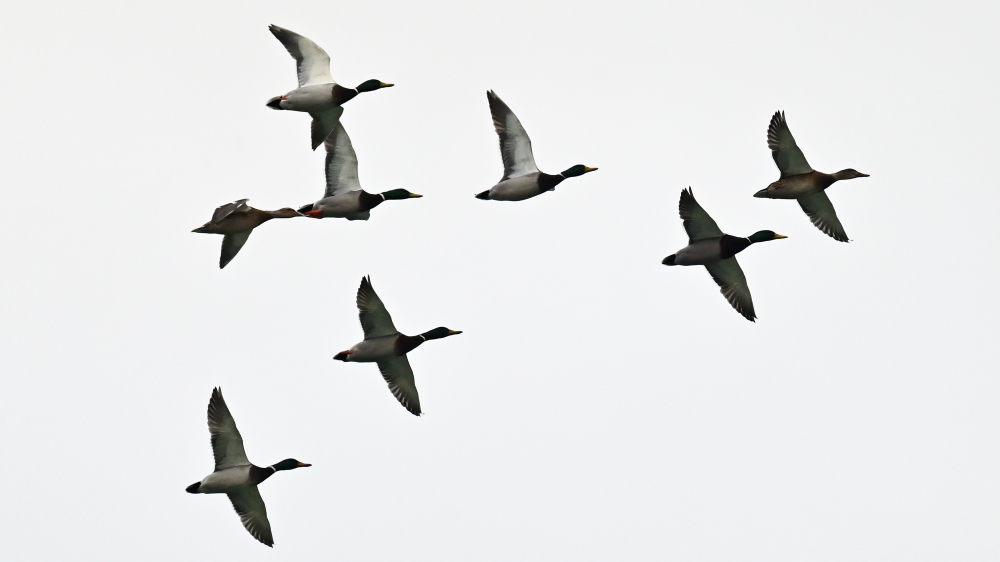
Heldigvis blev det endnu en fin dag med Gråænder (Anas platyrhynchos). De bliver ofte kaldt for franskbrødsænder og skydeænder, men ved Gedser Odde kommer de som ægte vilde fugle, og især dagens største flok på 28 lunede dybt ind i sjælen.
Kun få af småfuglene kommer videre fra fuglestationens have helt ud til spidsen. Vi har ingen rastende fugle i krat eller buske, og i trækket ud over havet så vi bare tre Sanglærker (Alauda arvensis).
Se alle dagens observationer fra Gedser Odde i DOFbasen.
Folk på stationen: Klaus Dichmann, Henrik Jørgensen, Ole Friis Larsen.
Flot træk af Store Skalleslugere
Ringmærkningen: Som prognosen sagde var vejret perfekt med ingen vind og skyet og så vind fra nord, og det kunne både ses og høres.
Der var dog tomme net frem til runden 9.15 hvor der sad både grøn-og gråsisken. Senere omkring klokken 11 kom der mere fart på nettene og dagen endte med 33 fangede fugle hvoraf de 31 var nye.
Hans kom ud kort efter middag og sammen fik vi taget de 2 hejsenet ned for i år, så nu er der kun 3 spejlnet og de 2 høgenet tilbage.
Vejret for i morgen ser ok ud med svag vind fra syd og overskyet, så det kunne godt give lidt igen.
Dagens ringmærkning og kontroller/Todays ringing and recaptures:
Gærdesmutte/Wren (1)
Rødhals/Robin (1)
Grønsisken/Siskin 30
Lille gråsisken/Lesser redpoll 1
Total 31(2)
Trækket på Odden: En overskyet, men næsten vindstille morgen og formiddag gjorde dagens arbejde på sydspidsen til en lun fornøjelse, oven i købet med et pænt træk, som løb op i 2.100 fugle fordelt på 33 arter plus nogle ubestemmelige gæs, som fløj langt ude over havet. Trækket var mest intenst de første par timer med 100 Rødstrubede Lommer (Gavia stellata) i løbet af den første time, hvorefter der kun kom få fugle i smågrupper og lange intervaller. På samme måde faldt intensiteten i hele trækker hen over formiddagen, og den sidste time var der ikke meget at se ud over rastende andefugle på havet.
Værd at bemærke i dagens træk var i hvert fald 125 Gråænder (Anas platyrhynchos) og over 700 Sortænder (Melanitta nigra), men et mindre tal er egentlig dagens mest interessante: 75 Store Skalleslugere (Mergus merganser) er det hidtil største antal af den art på en dag ved Gedser Odde i de seneste år.
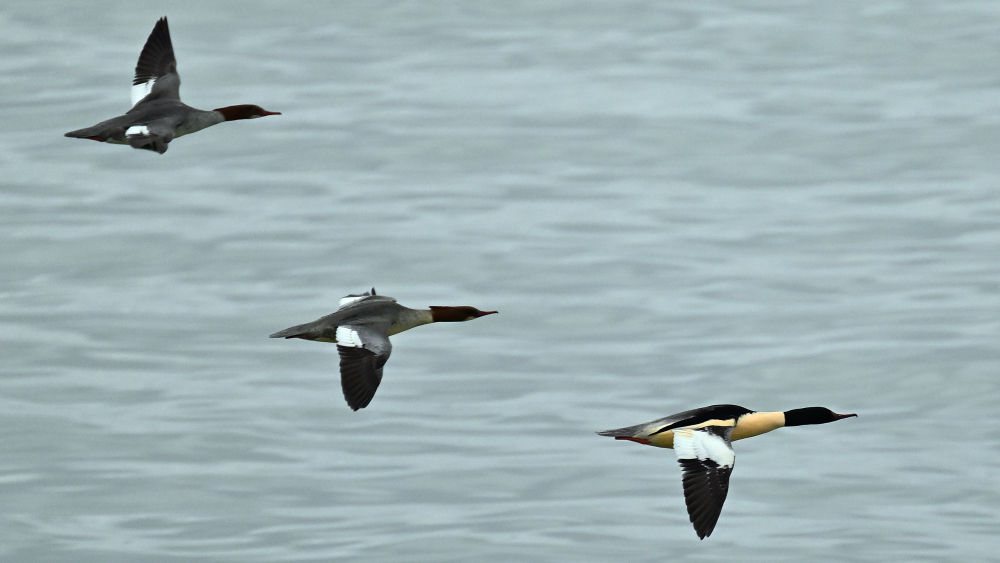
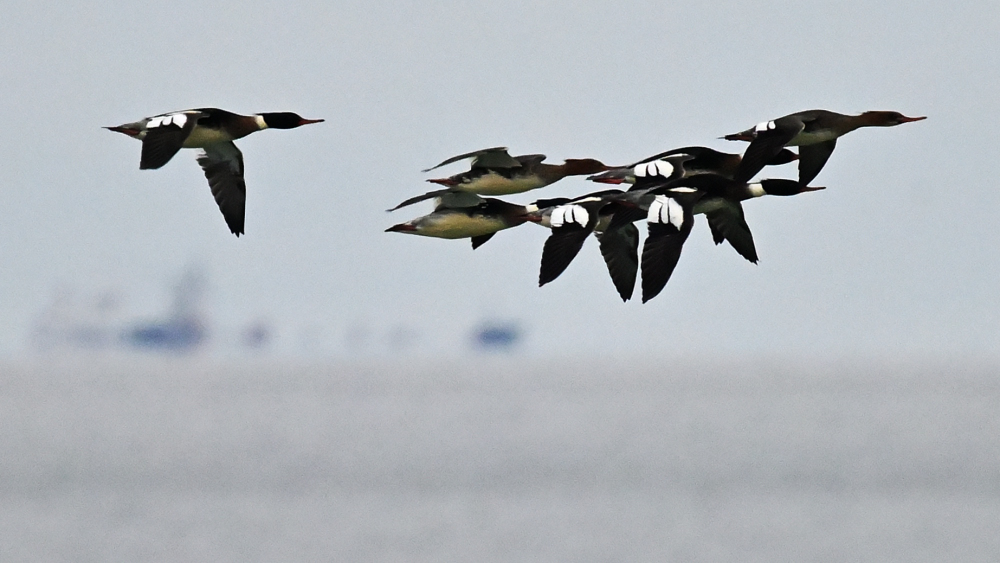
Artsmæssigt var det fint med tre arter af lappedykkere, og fra land var det sjovt med en flok på 14 udtrækkende Hulduer (Columba oenas). Hulduerne bliver normalt anset for trækfugle, der (stort set) forsvinder til mildere egne i Sydvesteuropa, men DOF’s punkttællinger viser, at antallet af overvintrende Hulduer i Danmark i de seneste ti år har været markant stigende, antagelig på grund af mildere vintre.
Nyt fra stationen: Uglespecialisten Klaus Dichmann arbejder i nogle dage med Gedser Fuglestation som base i et projekt, der skal forbedre forholdene for Slørugler (Tyto alba) i Lolland Kommune.
Se alle dagens observationer fra Gedser Odde i DOFbasen.
Folk på stationen: Klaus Dichmann, Henrik Jørgensen, Ole Friis Larsen.
Endelig flere fugle i nettene
Ringmærkningen: Der var næsten vindstille så de 2 hejsenet kom også op i dag.
Det kolde vejr havde tydeligt sendt lidt småfugle ned nordfra og flere flokke med grønsisken fløj over, men de så ikke ud til at trække ud.
Endelig var der også mere gang i fangsten og på et tidspunkt hang der 12 siskner i det ene net. Dagen endte med 18 fugle hvoraf de 15 var nye.
Vejret for i morgen er samme som i dag med skyet og næsten ingen vind så det kunne godt give lidt fugle igen. Vinden skulle komme fra nord så måske det kan give lidt siskner.
Dagens ringmærkning og kontroller/Todays ringing and recaptures:
Solsort/Blackbird 1(2)
Blåmejse/Blue tit (1)
Grønsisken/Siskin 14
Total 15(3)
Trækket på Odden: Til en afveksling var der næsten ingen vind onsdag morgen, men temperaturen var under en grad, så det blev en kold og grå oplevelse at observere et træk, der næsten var gået i stå. En enkelt Musvåge (Buteo buteo) repræsenterede et træk fra land, mens tre andre Musvåger vendte op ved mødet med havet og forsvandt tilbage mod nord.
Lige over 350 fugle fordelt på 21 arter i løbet af fem timer hører selvfølgelig med til vores dækning af efterårstrækket langt ind i december, hvor alle andre er stoppet, og derfor er det stadig en vigtig ’brik i puslespillet’.
På havet var der færre rastende fugle end i de seneste foregående dage, men en flok Havlitter (Clangula hyemalis) sørgede for god underholdning i et spil, som bragte dem tæt på land. En flok hanner så ud til at sværme om en enkelt hun, som tydeligt holdt sig til en enkelt han og højlydt afviste alle de andre, ind imellem angreb hun endda nogle af hannerne fysisk. En del af det interesssante var, at den udvalgte han overhovedet intet gjorde for at hjælpe hunnen eller forsøge at jage andre hanner væk.
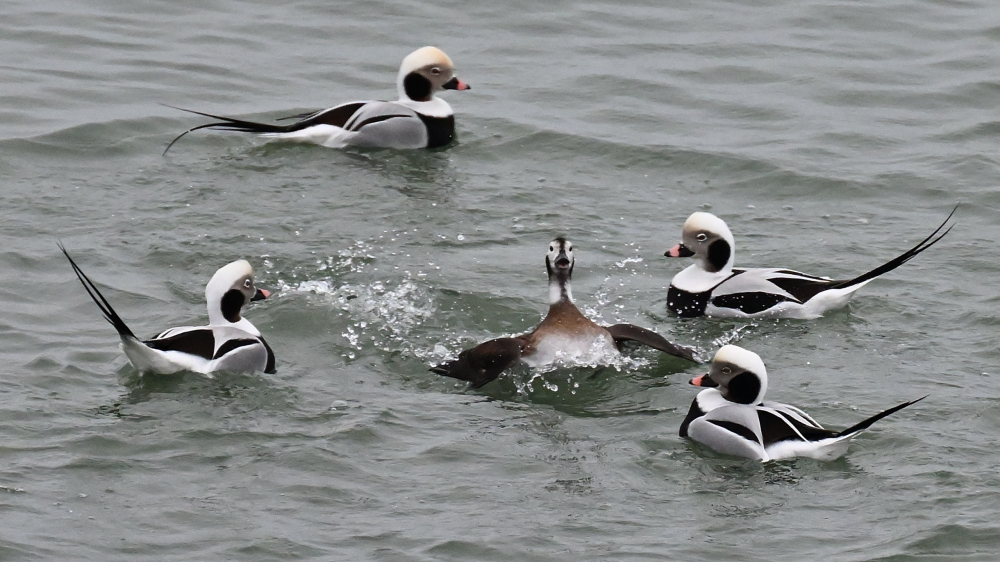
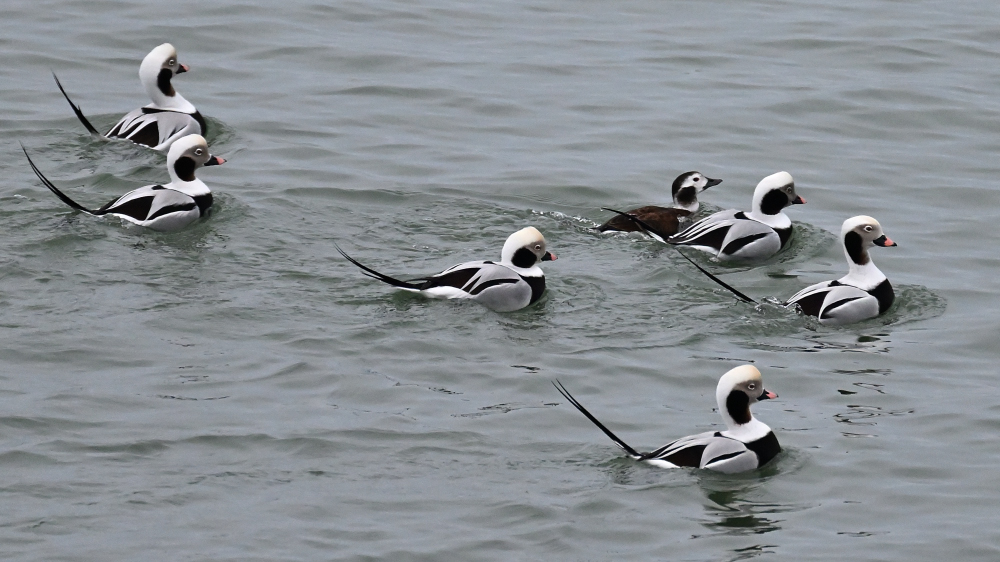
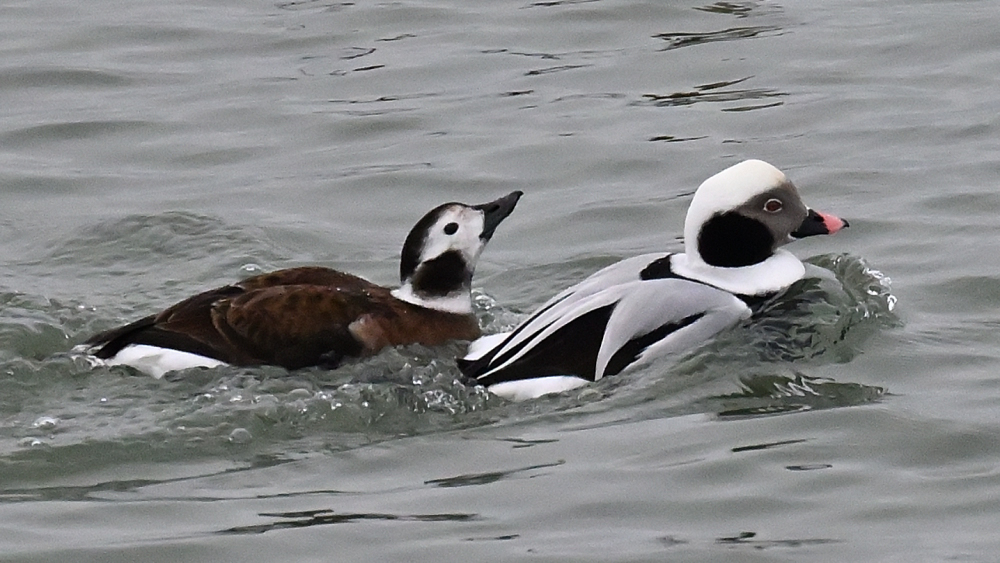
Havlitter er højarktiske ynglefugle, men en del overvintrer i danske farvande, blandt andet ud for Gedser Odde, hvor vi lige nu både ser Havlitter, som trækker forbi for at overvintre længere mod vest, og fugle, som i hvert fald indtil videre har slået sig ned ud for Odden. Havlitter er rødlistet som sårbare og fredet i Danmark, efter at den europæiske bestand siden 1990’erne antages at være faldet fra 4,7 millioner til 1,6 millioner fugle. Læs meget mere om vores fugle på Danmarks Fugle i DOFbasen. Her er et link til artiklen om Havlit, men her i dagbogen/blokken er det ofte også muligt at klikke på en art, fordi vi har gjort artsnavnet til et link.
Se alle dagens observationer fra Gedser Odde i DOFbasen.
Folk på stationen: Henrik Jørgensen, Ole Friis Larsen.
Sorte ænder og Sølvmåger
Ringmærkningen: Det var meget mørkt da nettene skulle op, men det var hurtigt klaret med pandelampe på. Da jeg ser mod Gedser by var der blandet farver på himlen dog svagt og i Sverige har jeg tidligere set nordlys så jeg henter hurtigt Ole og han giver mig ret i at det ligner svagt nordlys.
Dagen gik meget stille med en enkelt solsort på runden klokken 8, men vinden var også lige i overkanten til at starte med og meget vind fører sjældent småfugle med sig.
Der var dog senere enkelte småfugle som fløj over, dompap grønirisk og engpiber, men de trak ikke ud.
I morgen ser det godt ud med svag vind og ingen regn.
Om aftenen fik vi ryddet godt ud i køleskabene, så de er snart tømte for i år.
Dagesn ringmærkning/Todays ringing:
Solsort/Blackbird 1
Total 1
Trækket på Odden: En overskyet og forblæst morgen stadig med relativ hård vind var nordøst, så det var nødvendigt at søge læ ved den gamle marinestation, men selv om der kun var en enkelt observatør, gik tiden hurtigt. Der var et udmærket træk af sorte ænder, og der var en del måger, som ledte efter mad i brændingen langs stranden. Nogle fuglefolk specialiserer sig ligefrem i måger, mens andre synes, at det er kedeligt eller besværligt, fordi de ligner hinanden, men efterhånden er der gode bøger at lære af, og så er mågerne en rigdom af variationer og udfordringer. Hvorfor skal det være nemt, når det kan være sjovt og lærerigt?
Trækket over havet løb op i næsten 1.700 fugle af 24 arter, hvoraf halvdelen var Sortænder (Melanitta nigra) med 818. Desuden lå der mindst 430 og rastede på havet. De plejer at ligge længere ude end Ederfuglene (Somateria molissima), men denne morgen var det omvendt. Sortænderne lå tæt pakket tæt på land og var til at studere i teleskop, mens Ederfuglene lå længere ude og kun røg på, hver gang en af lodsbådene pløjede gennem deres rasteområde.
En anden sjov oplevelse var 28 Snespurve (Plectrophenax nivalis), som på et tidspunkt rastede et øjeblik på vejen ved marinestationen. En halv time før kom en gruppe på fem ind fra havet, men hvor resten kom fra forbliver ukendt.
Sølvmågerne (Larus argentatus) har det ikke godt med, at vi har lukket minkfarmene, lossepladserne, og der ikke er meget fiskeri tilbage. Undersøgelser har vist, at de har svært ved at finde mad til ungerne, og bestandene rundt omkring nærmest er i frit fald, Men denne tirsdag var der Sølvmåger i alle aldre og mindst to varianter at se ved Odden.
Her er nogle billeder med kommentarer baseret på hjemmearbejde med Gulls of North America, Europe and Asia af Klaus Malling Olsen og Hans Larsson, 2003, samt Gulls of Europe, North Africa, and the Middle east – An Identification Guide af Peter Adrians, Mars Muusse, Philippe J. Dubois og Frédéric Jiquet, 2021:
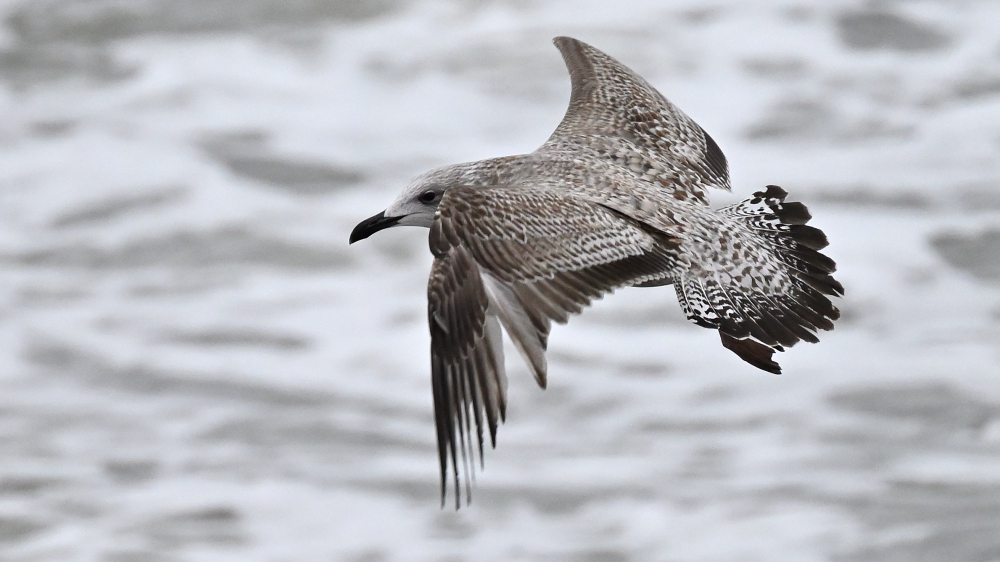
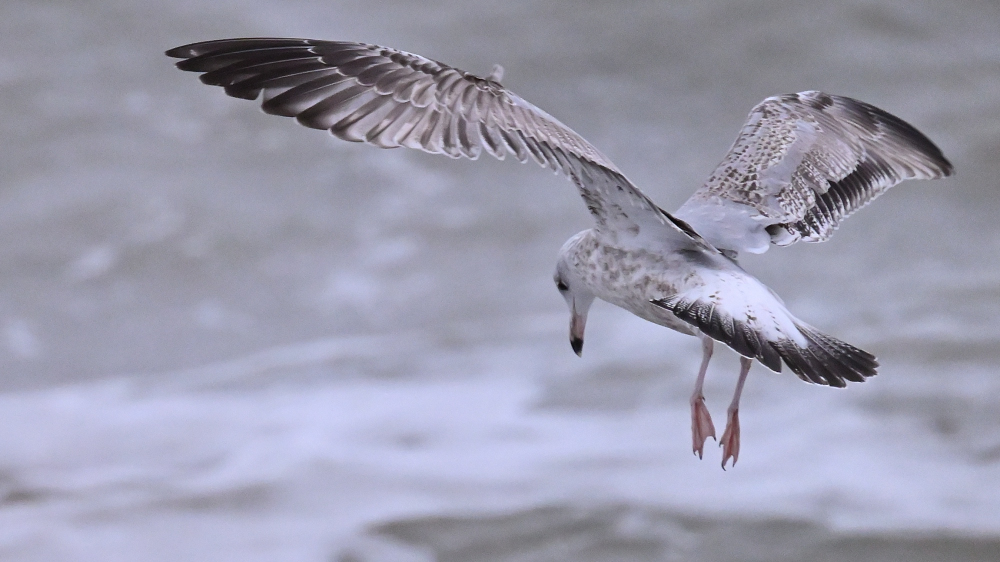


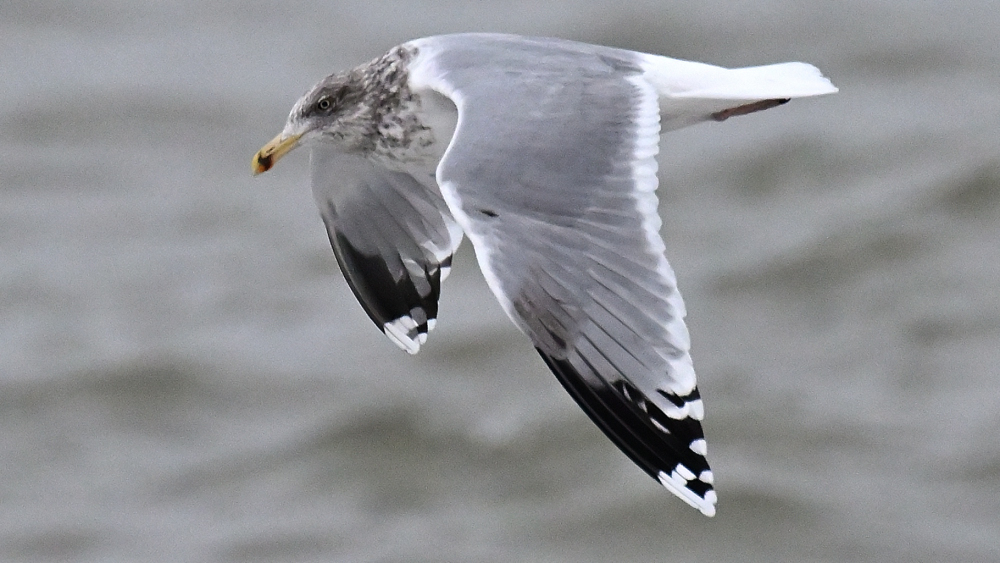
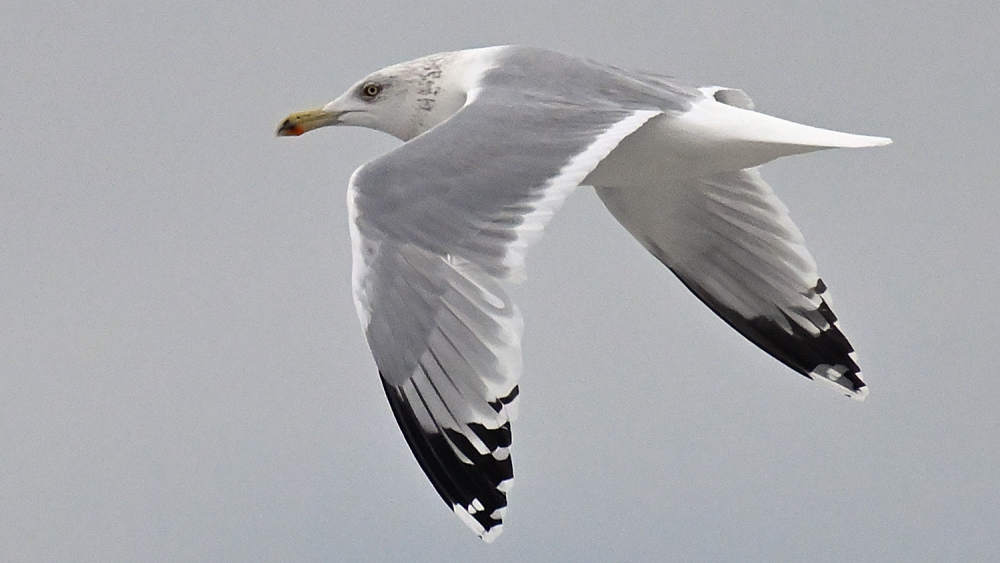
Se alle dagens observationer fra Gedser Odde i DOFbasen.
Folk på stationen: Henrik Jørgensen, Ole Friis Larsen.
'En halv pelikan' på Odden
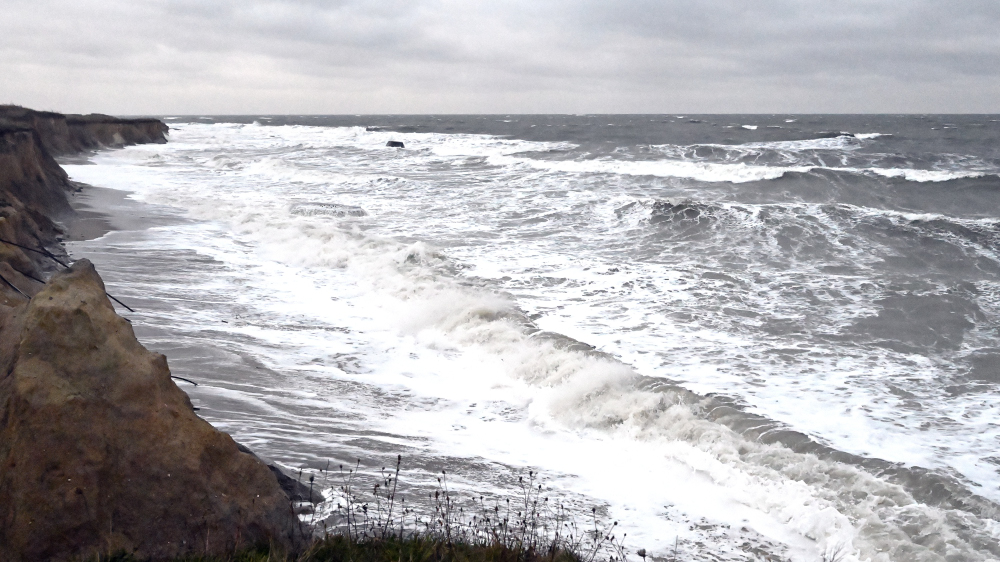
Mandag var der hverken ringmærkning eller træktælling på Odden for Gedser Fuglestation.
En hård vind fra nordøst blæste op til 22 meter i sekundet og gjorde det uforsvarligt at sætte net op til ringmærkning. På havet gav vinden flere meter høje bølger ind over stranden og helt op til kystskrænten, men det var ikke derfor, vi ikke fik talt træk. Det skyldtes ganske enkelt et møde i Fuglenes Hus i København, så der alligevel ikke ville have været tid til at tælle i mere end tre af de fem standardtimer.
Vi nåede dog en kort tur ud på Odden for at se stormen ved selvsyn. Der mødte vi en erfaren træktæller, Preben Berg, så der kommer nok nogle tal for denne dag i DOFbasen alligevel.
Tirsdag bliver der talt træk igen for fuglestationen, men vejrudsigten tyder på, at stormen kun tager langsomt af, så det er usikkert, om vi kan komme til at sætte net op til ringmærkning.
Folk på stationen: Henrik Jørgensen, Ole Friis Larsen.
Suler i massevis og en Sabinemåge
Ringmærkningen: Da der var regn da jeg stod op og der var mere på vej afventede jeg til det blev lyst, og 8.15 var alt sat op.
Det var dog en tam dag med en aflæst rødhals, og på lukkerunden 12.15 var der en lille gråsisken uden ring så dagen var ikke spildt selv om jeg var lidt misundelig på de 2 observatøres fine arter.
Der var masser af tid mellem runderne så der blev både vasket og gjort lidt rent.
I morgen skal det både små regne og være vind på 11-12 m/s så der tror jeg ikke der bliver noget fangst.
Dagens ringmærkning og kontrol/Todays ringing and recapture:
Rødhals/Robin 0(1)
Lille gråsisken/Lesser redpoll 1
Total 1(1)
Trækket på Odden: Bortset fra kulden og mørket er der forrygende dage i december på hele Nordens sydspids, denne søndag var en af dem. Vi var to observatører på job for fuglestationen på en dag med vind direkte fra øst, småregn i det første par timer og ellers mest overskyet vejr, men det var ingen hindring for fuglene. Vi fik talt næsten 2.100 fugle fordelt på 28 arter med flere bemærkelsesværdige og fine oplevelser hen over morgenen og formiddagen.
Morgentællingen begyndte med en lille flok Rødstrubede Lommer (Gavia stellata) ude i mørket før solopgang, og de blev ved med at strømme forbi gennem alle fem timer. Det blev til 224 i et sent træk, som ikke ser ud til at blive dækket dagligt noget andet sted i Østersøen.
Det er i den forbindelse interessant, at der hver dag er op mod 400 opslag på vores ’internationale ansigt’, den hollandske database Trektellen, som vi bruger parallelt med DOFbasen, der er vores danske ansigt og sikrer, at DOF/BirdLife Danmark altid har råderet over data fra vores registreringer af trækket ved Gedser Odde.
Siden kom et for Gedser Odde stort antal Suler (Morus bassanus). Vi endte med at anslå det samlede antal til 26 fra nord mod sydvest, idet vi antog, at Suler fra sydvest var fugle, der var vendt om og kom tilbage, efter at vi allerede havde talt dem en gang. Flere af Sulerne fouragerede længe ud for Odden. På et tidspunkt havde vi syv samtidig. På et andet tidspunkt opdagede vi en stor Vandrefalk (Falco peregrinus), som angreb tre af Sulerne ude over havet. Vandrefalken havde endda fat i halen på en af de hastigt flygtende Suler, før den var tilfreds og fløj ind over land. Vi så kun falken i silhuet og kunne derfor ikke sætte nogen alder på den, men den var stor og derfor sikkert en hun.
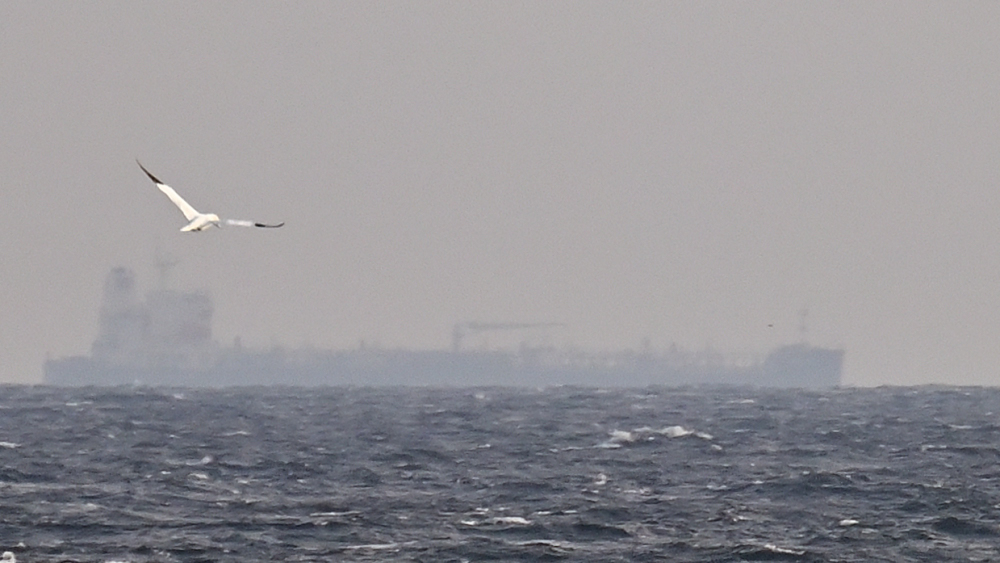
En flok på 17 forbitrækkende Hættemåger (Chroicocephalus ridibundus) viste sig også at rumme en ung 1k (første kalenderår) Ride (Rissa tridactyla) samt en 1k Sabinemåge (Xema sabini), som er en sjælden trækgæst i Danmark. Vi har en gang fået et tip om, at unge Rider ved Gedser Odde sandsynligvis er højarktiske fugle fra Sibirien, som i perioder med østlige vinde, som vi har haft på det seneste, trækker ned over Finland og gennem Østersøen i stedet for nord om Norge. Sabinemågerne yngler endnu længere østpå i Sibirien. Ved Gedser Odde er der set tre i dette efterår, og det er ikke usandsynligt, at de er kommet på samme måde som Riderne.
I dagens træk var der også almindelige arter, men i bemærkelsesværdige antal som næsten 470 Fløjlsænder (Melanitta fusca) og over 700 Sortænder (Melanitta nigra). Værd at bemærke var desuden et større antal store måger, såsom 60 Svartbage (Larus marinus) og 84 Sølvmåger (Larus argentatus), som trak og fouragerede undervejs. Vi talte om, at der måske var en sammenhæng mellem de relativt store forekomst af Suler og store måger ud for Odden – for eksempel en stor forekomst af føde. Vi så flere gange Suler og Svartbage fouragere tæt på hinanden.
Tak til Louis A. Hansen fra Gedser for godt selskab og assistance til tælleriet på en kold decembersøndag.
Se alle dagens observationer fra Gedser Odde i DOFbasen.
Folk på stationen: Henrik Jørgensen, Ole Friis Larsen.
Så var der bingo!
Ringmærkningen: Nettene bliver pt sat op 6.45 mens det er helt mørkt, og hvis nogen undrer sig hvorfor de kommer op så tidligt er det pga dagens højdepunkt(for ringmærkningen).
Første runde var tom, men på runden kl 8 sidder der en solsort i det første høgenet og mens jeg piller den ud kan jeg se at en lidt større fugl hænger i det andet høgenet og hurtigt kommer jeg hen og kan se at det er efterårets første skovsneppe. Og i næste net hænger 2 kvækerfinker. Alle fugle var på klokken 8 runden!
Skovsneppe er ikke en fugl vi fanger mange af, faktisk er de sidste mange taget i eftersæsonen i sent november eller start december hvor de ankommer fra de nordlige og østlige egne. Skovsneppen er en almindelig fugl i Danmark, men den lever ret skjult og så er den nataktiv så normalt når man støder på dem er det fugle som hviler om dagen. Grunden til at vi ikke har fanget så mange tidligere er også at de nemt kan komme ud af de normale net vi fanger med, men høgenettet som jeg kalder det har større masker og derfor sidder større fugle fast i det.
I morgen loves der igen regn, så der vil jeg nok ikke kunne ringmærke, men så tager jeg på Odden istedet.
Foto: Henrik Jørgensen
Dagens ringmærkning/Todays ringing:
Skovsneppe/Woodcock 1
Solsort/Blackbird 1
Kvækerfinke/Brambling 2
Total 4
Trækket på Odden: Tre observatører på arbejde for fuglestationen på en våd formiddag med vind fra sydøst og en diset udsigt over havet. Det gav en masse godt selskab og frisk luft plus et udmærket træk. I alt blev det til næsten 1.350 fugle fordelt på 27 arter, hvoraf en var dette efterårs anden Lille Skallesluger (Mergellius albellus), registreret ved Gedser Odde, en hunfarvet fugl i en lille flok Fløjlsænder (Melanitta fusca).
Vi endte med hele syv Suler (Morus bassanus). Fire af dem så vi på samme tid, en var ikke helt udfarvet, alle de øvrige var adulte/voksne fugle, som var lidt svære at holde rede på. Alle kom fra nord, men efter de første passager dukkede et par stykket op, som arbejdede sig fra sydvest mod nord, mens de ledte efter mad og dykkede. Det kunne være nye fugle, eller det kunne være nogle af de tidligere forbiflyvende, der var vendt om og kom retur. Måske så vi altså flere, men vi endte altså med en samlet vurdering på syv, hvilket også er et fint tal på denne lokalitet – og en smuk oplevelse af de styrtdykkende havfugle.
Fint var det også med lige under 100 Fløjlsænder, næsten 160 Rødstrubede Lommer (Gavia stellata), 58 Dværgmåger (Hydrocoleus minutus) og en enkelt sen Skeand (Spatula clypeata) i en flok Gråænder (Anas platyrhynchos)
Se alle dagens observationer fra Gedser Odde i DOFbasen.
Folk på stationen: Henrik Jørgensen, Ole Friis Larsen.
Interessant træk af måger
Ringmærkningen: Som prognosen i går aftes sagde ville der komme regn og den holdt desværre stik, men så fik jeg lavede datatjek hurtigt og tog ud og hjalp til i det våde vejr med at tælle trækket.
I morgen skulle det holde tørvejr så der burde kunne fanges igen.
Trækket på Odden: På en regnfuld morgen og formiddag var vi to fra fuglestationen til dagens tælling. Vinden lagde hårdt ud med over 10 meter i sekundet fra en østlig retning, men faldt hen over formiddagen helt ned til 5,1 meter i sekundet. På grund af flere timers støvregn var der diset over havet, og vi kunne ikke se ret langt. Til gengæld bragte vinden nok nogle fugle tættere på lande, og der var egentlig ikke noget at være utilfreds med. Der kom 933 fugle af 17 arter, og sammenlignet med 2022 og 2023 var det et mere interessant træk.
Årstiden er til få arter. Der var ingen tælling 6. december 2023, men 7. december sidste år var vi to om at registrere 99 fugle fordelt på 12 arter på en dag, der også bød på lav sigtbarhed over havet ned til 500 meter. Et år længere tilbage var vi to om at tælle 887 fugle af 17 arter 6. december 2022, hvoraf en tredjedel var Hjejler (Pluvialis apricaria), som trak mod nord.
Denne fredag 6. december bød på lige over hundrede Fløjlsænder (Melanitta fusca) og 86 Dværgmåger (Hydrocoleus minutus) som de mest interessante. Dværgmågerne har en meget lang træktid ud af Østersøen om efteråret, og det er ikke usædvanligt at opleve pæne flokke af de små måger med sorte vingeundersider ved Gedser Odde i december. Fredag var de to største grupper på 14 og 22 fugle.
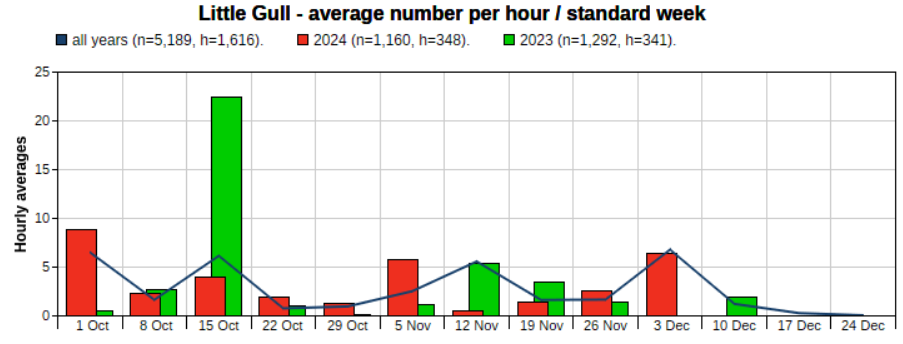 Grafikken viser det langvarige træk af Dværgmåger ved Gedser Odde. I år har trækket (røde søjler) stort set fulge normalkurven og kan ventes at forsætte lidt endnu. Sidste år var der et usædvanligt træk midt i oktober (grønne søjler). Den sorte kurve viser gennemsnittet over flere år. Kilde: Trektellen
Grafikken viser det langvarige træk af Dværgmåger ved Gedser Odde. I år har trækket (røde søjler) stort set fulge normalkurven og kan ventes at forsætte lidt endnu. Sidste år var der et usædvanligt træk midt i oktober (grønne søjler). Den sorte kurve viser gennemsnittet over flere år. Kilde: Trektellen
Værd et bemærke var også et fint træk af Hættemåger i dagens første time. Det blev til lige under 80 i løbet af alle fem standardtimer. I det hele taget foregår dagens træk lige for tiden i løbet af de første to timer, hvorefter det ebber ud til næsten ingenting i de sidste to timer.
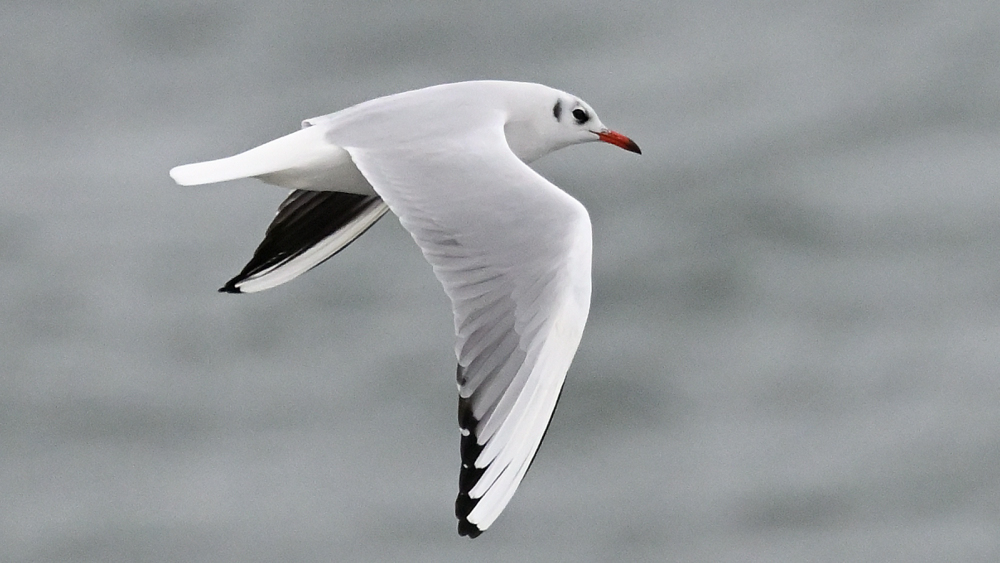
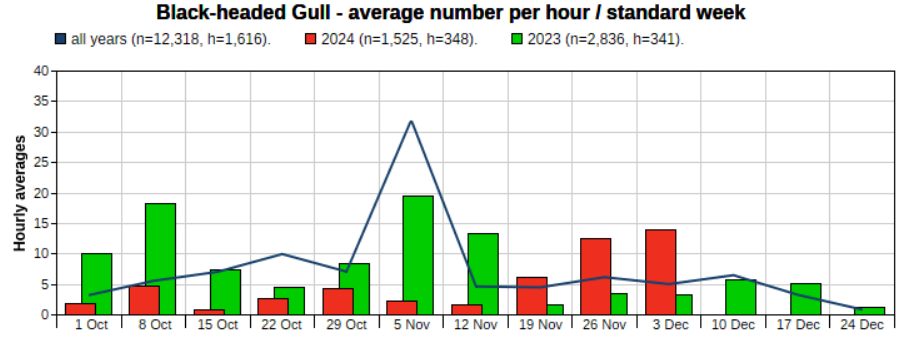
Se alle dagens observationer fra Gedser Odde i DOFbasen.
Folk på stationen: Henrik Jørgensen, Ole Friis Larsen.
